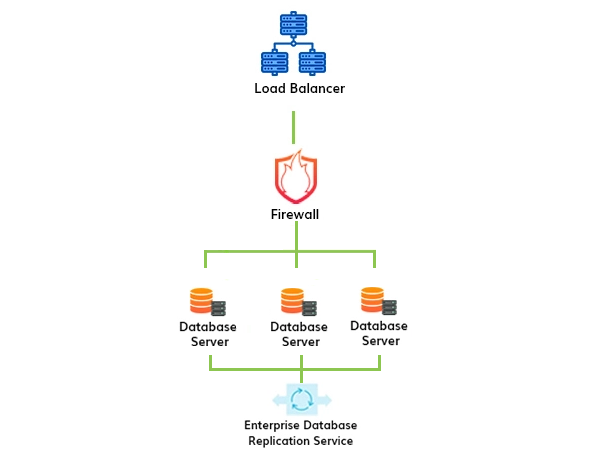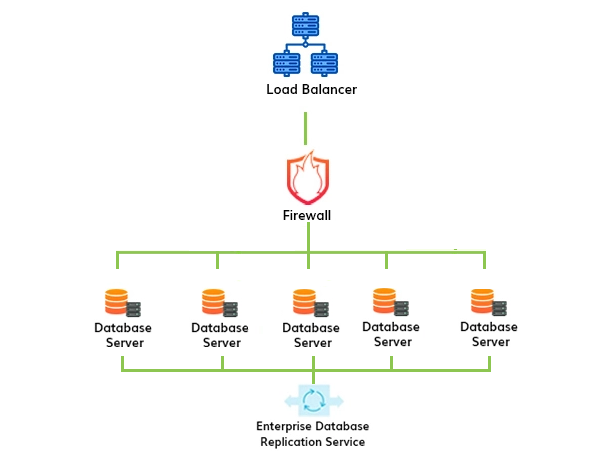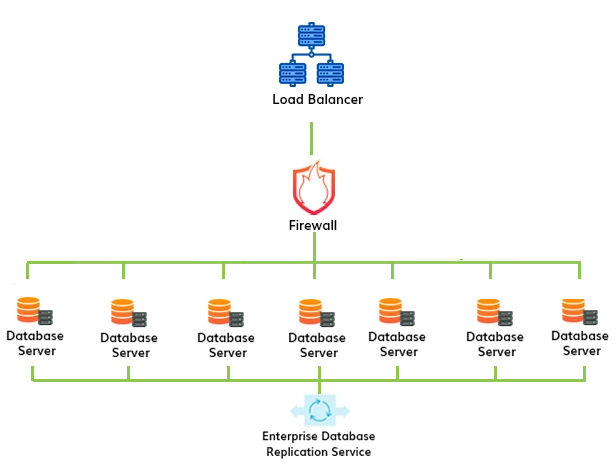MongoDB Cluster: High-Availability and Scalability Solution for Modern Applications
1) High-Availability: MongoDB Cluster provides a high-availability solution for modern applications. With a master-slave replication architecture, data is continuously replicated across multiple nodes in real-time. This ensures that even if one node fails, the other nodes can continue to serve requests and ensure data availability.
2) Scalability: MongoDB Cluster also provides horizontal scalability, which means that you can easily add more nodes to the cluster to handle increasing data volumes and traffic. This ensures that your application can continue to perform at peak levels even as your data grows
What is a MongoDB Cluster?
A MongoDB Cluster is a distributed database system that is composed of multiple servers, known as nodes, that work together to provide high availability, scalability, and fault tolerance for MongoDB databases. The nodes in a cluster can be located in different geographic regions or data centers, and they communicate with each other using a protocol known as the MongoDB replication protocol.
How many types of MongoDB clusters?
In a MongoDB cluster, there are two types of nodes: replica set nodes and sharded cluster nodes. Replica set nodes are responsible for providing high availability and fault tolerance for the database, while sharded cluster nodes are responsible for distributing data across multiple servers to achieve scalability.
Replica Set Cluster: Replica set nodes are organized in a primary-secondary configuration, where one node acts as the primary node, and the others act as secondary nodes. The primary node is responsible for processing all write operations and replicating data changes to the secondary nodes. If the primary node fails, one of the secondary nodes is elected as the new primary, ensuring that the database remains available and operational.
Sharded Cluster: Sharded cluster nodes, on the other hand, are responsible for partitioning data into smaller chunks, called shards, and distributing them across multiple servers. Each shard contains a subset of the data stored in the database, and sharded cluster nodes are responsible for routing read and write operations to the appropriate shard.
Within each of these two main types of clusters, there are different configurations and deployment options available to suit different use cases and requirements. For example, in a sharded cluster, you can choose to use a range-based or hash-based sharding strategy, or you can configure different shard zones to control how data is distributed.
In a MongoDB cluster, there are three main components: config servers, query routers, and shard servers. Config servers store metadata about the cluster, such as the location of the shards and the distribution of data. Query routers, also known as mongos instances, are responsible for routing client requests to the appropriate shard. Finally, shard servers store the data shards and handle read and write operations.
The main benefits of using a MongoDB cluster include high availability, scalability, and fault tolerance. By distributing data across multiple servers and providing redundancy, the cluster ensures that the database remains available even if one or more nodes fail. Additionally, the cluster can scale horizontally by adding more nodes, making it possible to handle increasing amounts of data and traffic. Finally, the cluster is fault-tolerant, meaning that it can continue to operate even in the face of hardware or software failures.
How to do MongoDB cluster setup with HostingRaja?
Our company offers a MongoDB Cluster Service, which enables you to customize your database cluster with ease using our client area Dashboard. You can view your cluster database server details, including the master database and slave database details such as the database hostname, IP address, and console access option.
3 Node Cluster
3 Database Servers
Load Balancer (FREE)
Firewall
5 Node Cluster
5 Database Server
Load Balancer (FREE)
Firewall
7 Node Cluster
7 Database Servers
Load Balancer (FREE)
Firewall
If you have purchased multiple database server clusters, you can use “db1.yourdomain.com” as the master database server to upload your databases. You can create a database and user from our cluster dashboard to ensure that only your database works from your load balancer server. Replication between the master and slave servers is automatic, providing you with greater efficiency.
Our MongoDB Cluster service is designed to provide you with a flexible and scalable solution that meets your specific needs. With our intuitive Dashboard, you can easily manage your database cluster. We also offer 24/7 support to ensure that you get the most out of our service.
How to set up MongoDB Cluster on your own Linux VM?
Cluster Setup Procedure
You will need a different system to set up each component in a production environment. However, we will set all processes on a single server for this purpose.
Step 1: Create folders to represent the shards and config servers.
The first step is to create different folders. First, create three config folders for the config servers, then three shard folders for the individual replica sets. The code will look something like this:
Step 2: Start the config servers
After all, the configuration servers have started, log into the first server on port 26050:
Initiate the first shard instance using the following command:
When all the instances are up and running, start the shard and initiate shardsvr replication.
First, log into the a0 instance, then initiate replication:
Step 4: Start the Mongos instance.
The next step is to start the mongos. Mongo serves as an interface between the client and the sharded environment. Start the mongos instance through the following line:
To check the status of your sharded environment, you can run the command:
Adding Databases and Collections to Shards
config 0.002GB
mydb 0.000GB
What is the use of MongoDB Cluster?
The use of a MongoDB Cluster is to provide high availability, scalability, and fault tolerance for MongoDB databases.
Here are some of the key benefits of using a MongoDB Cluster:
Flexible database: MongoDB’s flexible database structure allows users to store data in any format or structure, without the need for a pre-defined schema. This makes it ideal for applications where data is constantly changing or where the structure is unknown upfront.
Sharding: MongoDB allows you to distribute large amounts of data across several servers, using its auto-sharding feature. This means that even if one server fails, the others can still handle the load, ensuring high availability and scalability.
High speed: MongoDB is a document-oriented database that allows fast query responses due to its indexing capabilities. Its speed is approximately 100 times faster than traditional relational databases, making it a popular choice for high-performance applications.
High availability: MongoDB’s replication and gridFS features provide high availability and data redundancy. This means that if one server fails, another can take over without any downtime.
Scalability: MongoDB is horizontally scalable, meaning you can add more servers to your cluster to handle increasing amounts of data, while maintaining performance.
Ad-hoc query support: MongoDB supports ad-hoc queries, allowing you to query data in real-time, without the need for pre-defined queries or schemas. This provides great flexibility for developers and simplifies the development process.
Easy environment setup: MongoDB is easy to install and set up, with a simple configuration process. It also provides a JavaScript client for queries, making it easy to integrate with your application.
Full technical support: MongoDB Inc. provides professional support to its clients, with 24/7 access to MongoDB client support system, providing assistance when needed.
What are the limitations of the MongoDB Cluster?
Complexity: MongoDB Clusters can be complex to set up and maintain. The configuration and deployment of a cluster require careful planning and consideration of the specific requirements of your application. Managing a cluster can also be complex, requiring knowledge of MongoDB’s cluster management tools and best practices.
Cost: MongoDB Clusters can be expensive to set up and maintain, especially in large-scale deployments. The cost of hardware, software, and maintenance can add up quickly, making it challenging for small or budget-constrained organizations to adopt a MongoDB Cluster.
Consistency: In a Sharded Cluster, MongoDB may not provide strong consistency guarantees. This is because data is partitioned across multiple nodes, and it may take some time for updates to propagate to all nodes. This can result in some queries returning stale data or inconsistencies in the data.
Limited Transactions: MongoDB’s support for transactions is limited in some configurations. For example, MongoDB’s support for multi-document transactions is limited in a Sharded Cluster, which can make it challenging to implement complex data integrity checks or transactions that span multiple shards.
Performance Overhead: In some cases, the overhead of maintaining a MongoDB Cluster can impact performance. For example, in a Sharded Cluster, the query router (mongos) can add overhead to query execution, resulting in slower query performance compared to a non-sharded cluster.
How HostingRaja’s 24/7 Managed Support for MongoDB cluster helps you?
Providing 24/7 support for a MongoDB cluster involves ensuring that the database system remains available and operational at all times. Here are six key points to consider when providing support for a MongoDB cluster:
Monitoring: Monitoring the health and performance of the cluster is essential for identifying and resolving issues before they affect the system. Tools such as MongoDB Cloud Manager or Ops Manager can provide real-time monitoring and alerting for the cluster.
Automation: Automating routine tasks, such as backups, updates, and failover, can help reduce the risk of human error and ensure that the system is always running optimally. Tools such as Ansible or Puppet can be used to automate these tasks.
Security: Ensuring that the MongoDB cluster is secure is critical for protecting sensitive data. This involves implementing appropriate security measures, such as firewalls, access controls, and encryption, and regularly reviewing and updating security policies.
Disaster Recovery: Having a disaster recovery plan in place can help minimize downtime and data loss in the event of a catastrophic failure. This involves regularly backing up data and having a plan in place for restoring the database in the event of a failure.
Response Time: When issues do occur, it’s essential to respond quickly to minimize the impact on the system. Having a dedicated support team available 24/7 to handle issues as they arise is critical for ensuring that the system remains operational.
Continuous Improvement: Finally, continuously improving the MongoDB cluster over time can help optimize its performance and ensure that it remains scalable and resilient. This involves regularly reviewing system metrics and performance data, identifying areas for improvement, and implementing changes to optimize the system.
Cost Savings: Hiring a full-time in-house DBA can be costly. HostingRaja database administration service can help reduce costs by only paying for the services needed, rather than having a full-time employee on payroll with benefits.
Access to Expertise: Database administration is a highly specialized field. Our 10+ years of experts can provide access to a broad range of skills and experience that may not be available in-house. This can help improve the overall performance, efficiency, and reliability of the database system.
Flexibility and Scalability: Our 24/7 Managed support gives you flexibility and scalability. As business needs change, you can easily adjust the level of service provided, adding or removing resources as needed.
Reduced Risk: HostingRaja team of experts can help reduce the risk of data breaches or other security concerns. External providers have a dedicated focus on security and can provide additional resources, such as data backups and disaster recovery plans.
24/7 Support: Our 24/7 managed support team can offer around-the-clock support, ensuring that any issues are promptly addressed, even outside of business hours.
Access to New Technologies: Our team often has access to the latest technologies and software updates. Outsourcing can provide access to new tools and features, ensuring that the database system remains up-to-date and optimized.
Improved Performance: HostingRaja database administration can help improve overall performance by ensuring that the database is properly optimized and configured for maximum efficiency.
Overall, HostingRaja’s database administration can provide cost savings, access to expertise, flexibility, reduced risk, 24/7 support, improved focus, access to new technologies, and improved performance.
FAQ’s
What are the benefits of MongoDB clustering?
MongoDB clustering offers several benefits, including increased read and write performance, improved scalability to handle large datasets and high traffic loads, automatic failover and high availability, and the ability to distribute data geographically for improved latency and disaster recovery.
How does MongoDB clustering work?
MongoDB clustering involves deploying multiple MongoDB servers in a cluster and configuring them to work together. It uses replica sets to provide automatic data replication and failover. The cluster is managed by a primary node that handles write operations, while secondary nodes replicate data from the primary node and handle read operations.
What is a replica set in MongoDB clustering?
A replica set within MongoDB clustering functions as a collective of MongoDB servers collaborating to ensure data redundancy and constant accessibility. It comprises a primary node, responsible for handling write operations, along with multiple secondary nodes tasked with mirroring data from the primary node. In the event of a primary node malfunction, an automatic election process takes place to designate one of the secondary nodes as the new primary.
How can I add nodes to a MongoDB cluster?
To add nodes to a MongoDB cluster, you can deploy additional servers and configure them as secondary nodes in the replica set. MongoDB provides tools and commands to add new nodes and initiate the replication process.
Can I distribute data geographically in a MongoDB cluster?
Yes, MongoDB supports data distribution across multiple geographic regions through sharding. Sharding involves dividing data into chunks and distributing them across multiple shards, which are separate replica sets. This allows you to scale horizontally and improve performance for globally distributed applications.
What happens if a node in the MongoDB cluster goes down?
If a node in the MongoDB cluster goes down, the remaining nodes continue to serve read requests and elect a new primary node if necessary. Once the failed node is back online, it can sync with the primary node and resume replication to ensure data consistency.
Can I perform backups in a MongoDB cluster?
Yes, you can perform backups in a MongoDB cluster using tools like mongodump or by taking snapshots of the underlying storage. It's important to ensure that backups capture data from all nodes in the cluster to maintain data consistency.
What are the considerations for choosing hardware for a MongoDB cluster?
When choosing hardware for a MongoDB cluster, factors to consider include CPU and memory capacity to handle the workload, fast storage with low latency and high throughput, redundant power supplies and network connections, and proper network configuration to minimize latency between nodes.
Is there a limit to the number of nodes in a MongoDB cluster?
MongoDB imposes practical limits on the number of nodes in a cluster based on factors such as network latency and the ability to maintain consensus. The recommended maximum number of nodes in a replica set is around 50, but it may vary depending on the deployment and specific requirements.
Reviews from MongoDB server Customers
-

Omkar Gaurav
11 Mar 2025I’m a software developer and I use HostingRaja’s MongoDB cluster service for my projects. It’s fast, reliable, and easy to use. I can easily scale my database up or down as needed, and I don’t have to worry about downtime. I would definitely recommend it to other developers.

Umesh kamble
23 Jan 2025I’m a small business owner and I use HostingRaja’s MongoDB cluster service for my website. It’s affordable and it’s been very reliable. I don’t have to worry about my website going down, and I can easily scale my database as my business grows. I would definitely recommend it to other small businesses.

Dayanand Jadhav
17 Apr 2025I’m a non-profit organization and I use HostingRaja’s 24/7 support for my MongoDB cluster. I’ve been very happy with the service. The technicians are always available when I need them, and they’ve always been able to help me resolve my issues quickly. I would definitely recommend HostingRaja to other non-profit organizations



